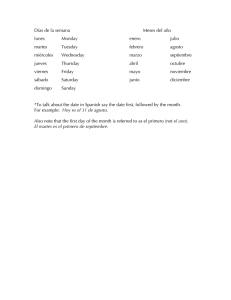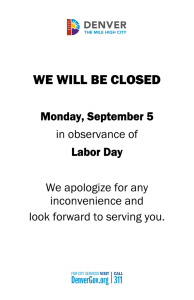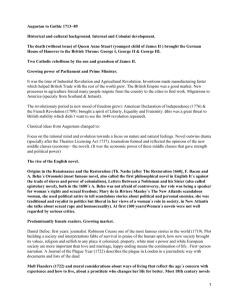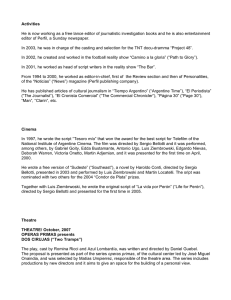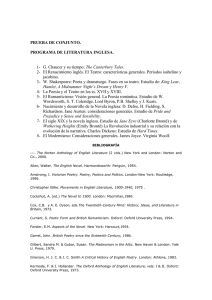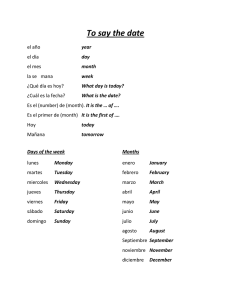The Historical Background of the Roaring Twenties
Anuncio
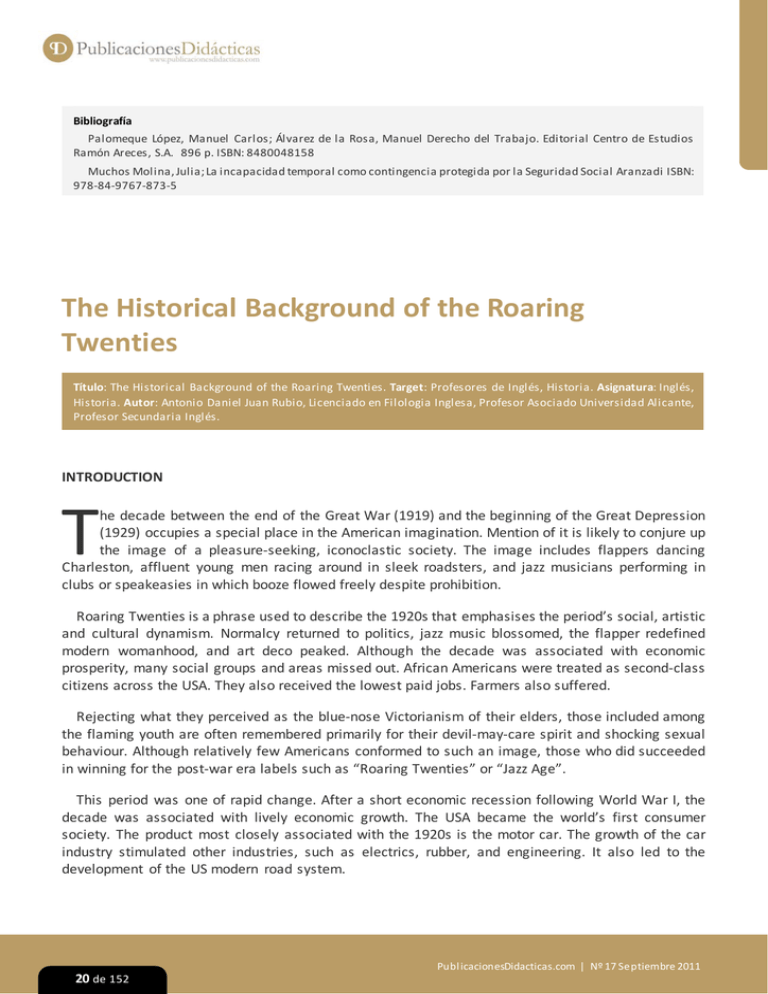
Bibliografía Palomeque López, Manuel Carlos; Álvarez de la Rosa, Manuel Derecho del Trabajo. Editorial Centro de Estudios Ramón Areces, S.A. 896 p. ISBN: 8480048158 Muchos Molina, Julia; La incapacidad temporal como contingencia protegida por la Seguridad Social Aranzadi ISBN: 978-84-9767-873-5 The Historical Background of the Roaring Twenties Título: The Historical Background of the Roaring Twenties. Target: Profesores de Inglés, Historia. Asignatura: Inglés, Historia. Autor: Antonio Daniel Juan Rubio, Licenciado en Filologia Inglesa, Profesor Asociado Universidad Alicante, Profesor Secundaria Inglés. INTRODUCTION T he decade between the end of the Great War (1919) and the beginning of the Great Depression (1929) occupies a special place in the American imagination. Mention of it is likely to conjure up the image of a pleasure-seeking, iconoclastic society. The image includes flappers dancing Charleston, affluent young men racing around in sleek roadsters, and jazz musicians performing in clubs or speakeasies in which booze flowed freely despite prohibition. Roaring Twenties is a phrase used to describe the 1920s that emphasises the period’s social, artistic and cultural dynamism. Normalcy returned to politics, jazz music blossomed, the flapper redefined modern womanhood, and art deco peaked. Although the decade was associated with economic prosperity, many social groups and areas missed out. African Americans were treated as second-class citizens across the USA. They also received the lowest paid jobs. Farmers also suffered. Rejecting what they perceived as the blue-nose Victorianism of their elders, those included among the flaming youth are often remembered primarily for their devil-may-care spirit and shocking sexual behaviour. Although relatively few Americans conformed to such an image, those who did succeeded in winning for the post-war era labels such as “Roaring Twenties” or “Jazz Age”. This period was one of rapid change. After a short economic recession following World War I, the decade was associated with lively economic growth. The USA became the world’s first consumer society. The product most closely associated with the 1920s is the motor car. The growth of the car industry stimulated other industries, such as electrics, rubber, and engineering. It also led to the development of the US modern road system. Publ icacionesDidacticas.com | Nº 17 Septiembre 2011 20 de 152 Was the 1920s a decade of wealth, experimentation and contradictions just in the US or rather it was a worldwide spread phenomenon? Did the period have the same effects and consequences in all the nations around the world? Before just focussing on the impact of the decade in the USA at a theoretical framework, we shall firstly consider the period from a global scale year by year with its most significant and relevant facts. HISTORICAL CONTEXTUALIZATION 1920 started politically with the coming into effect of Prohibition in the US, enforced three months later by the Volstead Act. Besides, the 19th Amendment guaranteed women the right to vote. At this time, Warren Harding wins the presidential election for the Republican Party. In Europe, a plebiscite in Schleswig establishes the border between Denmark and Germany. A communist uprising in the Ruhr is suppressed with difficulty by the German army, whereas the German Workers’ Party, with Adolf Hitler as one of its leading members, changes its name to the Nazi Party. The government of Ireland provides for separate parliaments in Southern Ireland and the six counties of Ulster. The brutal behaviour of the British police aggravates the violence in the country. The IRA and the British security forces clash during a violent ‘Bloody Sunday’ in Dublin. In the rest of the world, a national congress in Damascus proclaims Faisal King of an independent Syria, though French intervention forces Faisal off the throne and out of the country. Destour is formed as a nationalist party in Tunisia, demanding full independence from France. Mustafa Kemal is elected president of Turkey’s new Grand National Assembly. The League of Nations mandates give Britain responsibility for Iraq, Transjordan and Palestine, and France responsibility for Syria and Lebanon. The Haganah is set up as an underground military organization to protect Jewish settlements in Palestine. A punitive peace treaty is designed to dismember the Ottoman Empire. The sultan of Turkey signs the treaty with the Allies but it is rejected by the new nationalist government. In Mexico, ten years of violent revolution are brought to an end in a successful coup by Álvaro Obregón. It is in this year that the Meccano Company launches the first of its Hornby model trains. The Marconi Studio in the English town of Chelmsford broadcasts live to Europe and to ships on the Atlantic. This is a productive year in the literary field. Among some others, we can mention the following publications: Ezra Pound’s ‘Hugh Selwyn Mauberley’; Edith Wharton’s ‘The Age of Innocence’; Scott Fitzgerald’s ‘This Side of Paradise’; DH Lawrence’s ‘Women in Love’; Sinclair Lewis’ ‘Main Street’; or Agatha Christie’s ‘The Mysterious Affair at Styles’. It is also a great year for culture. Marie Rambert, a Polish dancer with the Ballets Russes, opens a ballet school in London. Richard Rodgers and Lorenz Hart work together creating the musical ‘Fly with Me’. Charles Ives publishes his Piano Sonata no. 2, usually known as the ‘Concord Sonata’. Publ icacionesDidacticas.com | Nº 17 Septiembre 2011 21 de 152 Actor Douglas Fairbanks makes the first of his adventure movies, ‘The Mark of Zorro’. The marriage of Mary Pickford and Douglas Fairbanks is a Hollywood sensation after a three-year affair. It is in 1921 when Franklin D. Roosevelt is paralyzed from the waist down by polio. The first of America’s unknown soldiers is paced in the new Tomb of the Unknowns in Arlington National Cemetery. In Britain, James Craig succeeds Edward Carson as leader of the Ulster Unionist Party in Northern Ireland becoming the first prime minister of the new parliament. The British Parliament ratifies the Anglo-Irish Treaty, but De Valera repudiates it and resigns as president of the Dáil. The Republican Party Sinn Fein is unopposed in Southern Ireland’s first general election, and so wins every available seat in the new parliament under the name Dáil Eireann (Assembly of Ireland). Envoys sent to London by De Valera agree independence for Southern Ireland as the Irish Free State. The Anglo-Irish Treaty ends the war between the British army and the IRA. Fascist movements began to arise in the old continent. With massive force and huge casualties, Lenin puts an end to a naval mutiny at Kronstadt. Mussolini and his fascist colleagues win seats in the Italian parliament. Adolf Hitler becomes leader of the Nazi Party in Germany, which now has about 3,000 members. Worldwide, Reza Khan becomes war minister after seizing control of Tehran with the Cossack brigade. Abdullah ibn Hussein becomes emir of the new province of Transjordan. Mao Zedong leads a delegation to the First Congress of the Chinese Communist Party in Shanghai. Abd-el-Krim wins a sensational victory over Spanish forces in Morocco and gains control of the Rif. This is an important year socially speaking since the first traces are found of a major but entirely forgotten civilization in the Indus valley. Marie Stopes and her husband set up in London a Mother’s Clinic for Birth Control, the first of its kind in Britain. At the same time, Alfred Adler opens the first of many child-guidance clinics in Vienna. Within a five-week period, the Italian playwright Luigi Pirandello writes two masterpieces ‘Six Characters in Search of an Author’, and ‘Henry IV’. Also Italian sex symbol Rudolph Valentino has two sensational hits ‘The Four Horsemen of the Apocalypse’ and ‘The Sheik’. Eugene O’Neill’s play ‘Anna Christie’ is performed in New York. Leos Janacek’s rhapsody ‘Taras Bulba’ is first performed in Brno, and his opera ‘Kortya Kabanova’ has also its premiere in Brno. 1922 started in the USA with the Teapot Dome scandal, which revealed corruption in the administration of President Warren Harding. This together with some other scandals will mark the decline of his presidency till his death. The reputation of UK Prime Minister Lloyd George suffers severely when he is accused of selling peerages to build a personal political fund until he loses his majority in the House of Commons. The Conservatives, under Andrew Bonar, win 347 seats in the British general election, giving them a large majority. The Labour Party, winning 142 seats and beating the Liberals, becomes the official opposition for the first time. Publ icacionesDidacticas.com | Nº 17 Septiembre 2011 22 de 152 Lenin has a stroke removing him for five months from active control of party and state. Before his second stroke, which finally put him out of action in political terms, he devised the structure for a new federal state, the Union of Soviet Socialist Republics (USSR). At a Congress in Moscow, four Soviet Republics (Russia, Belarus, the Ukraine, and the Transcaucasia Republic) agree to unite. In elections to the Dáil, the pro-treaty faction of Collins and Griffith defeat the opposition, led by De Valera. Bitter war breaks out between factions of the IRA supporting and opposing the Anglo-Irish Treaty. The Irish Free State takes stringent measures against rebel terrorism, making possession even of a pistol a capital offence. After Michael Collins is killed in an ambush, William Cosgrave emerged as leader of the Irish Free State, becoming finally the first prime minister after the 26 counties of Southern Ireland ratified the Anglo-Irish Treaty. In Italy, Mussolini gives orders for armed squads to congregate around Rome in preparation for a march to seize power in the capital. The Italian King, Victor Emmanuel III, alarmed at the prospect of a fascist march on Rome, asks Mussolini to form a government. A triumphant Mussolini arrives in Rome on the overnight train from Milan to take up his appointment as prime minister. Columns of Blackshirts parade before Mussolini and the King. The League of Nations introduces the Nansen Passport for stateless persons, and it gives France and Britain mandates to govern separate areas of the German colonies of Cameroon and Togoland. Ambrogio Ratti is elected pope and takes the name of Pius XI. Out of Europe, Egypt becomes an independent kingdom, subject to a British military presence to protect the Suez Canal. Mahatma Gandhi is arrested by the British in India as an agitator and is sentences to six years in prison. Mustafa Kemal Ataturk wins a long campaign to expel the Greeks, authorised by the Allies to occupy western Turkey. The nationalist government in Turkey abolishes the sultanate and the last Ottoman emperor, Mehmed VI, goes into exile. The Marconi Company pioneers in England a regular broadcasting service from its radio station near Chelmsford. John Reith becomes general manager of the newly formed British Broadcasting Company (BBC). The BBC launches a regular broadcasting service from the Marconi studio in London. British manufacturer Herbert Austin launches Britain’s first car, the ‘Austin Seven’. French fashion designer Gabrielle Coco Chanel introduces a very successful perfume, calling it ‘Chanel No. 5’. Canadian physiologists Frederick Banting and Charles Best isolate insulin from the pancreas for the treatment of diabetes. This is also a prolific year for culture and arts. James Joyce’s novel ‘Ulysses’ is published in Paris because of censorship problems elsewhere. D.H. Lawrence writes the bulk of his novel ‘Kangaroo’. John Galsworthy publishes his novels as a joint collection under the title ‘The Forsyte Saga’. Sinclair Lewis creates an archetypal character in ‘Babbitt’, a real-estate broker. Publ icacionesDidacticas.com | Nº 17 Septiembre 2011 23 de 152 Marina Tsvetaeva completes an anti-Soviet cycle of poems, ‘The Encampment of the Swans’. Boris Pasternak makes his name with his third volume of poems ‘My Sister Life’. T.S. Eliot publishes ‘The Waste Land’, an extremely influential poem. Thomas Mann publishes a fragment of his ‘Confessions of Felix Krull’. De Witt Wallace and his wife, working from home, publish the first issue of Reader’s Digest. Diego Rivera begins the first of his influential murals depicting Mexican history. The Broadway show ‘Ziegfeld Follies’ features an exciting new dance, the Charleston. In 1923, US President Warren Harding dies little more than half way through his term of office as president. Harding is succeeded by his Vice-President, Calvin Coolidge. Once more, Italy and Ireland become the main focus of political attention in Europe. In Italy, Benito Mussolini sets up a Fascist Grand Council as a token assembly to conceal his authoritarian rule. With Mussolini already installed as Il Duce, his party wins 65% of the votes in a general election. In Ireland, De Valera and the IRA lay down their arms, bringing to an end the Irish Civil War. Lenin’s third stroke prevents the publication of his testament, which urges upon the party the removal of Stalin. The USSR officially comes into being with a newly written constitution. France, with Belgium support, occupies Germany’s industrial heartland in the Ruhr when German inflation reaches fantasy levels. In Germany, communists organize uprisings in Saxony, Thuringia, and Hamburg. Adolf Hitler, launching a putsch in a Munich beer cellar, announces the birth of a new national government which ends in ignominious failure as he flees under fire. Herman Goring is wounded in the aftermath of the Munich beer cellar putsch, but unlike Hitler manages to escape. Adolf Hitler dictates ‘Mein Kampf’ to Rudolf Hess in their shared prison cell after the failed Munich putsch. Rudolf Hess suggests to Hitler the policy of Lebensraum or living space for the German people. In Britain, Stanley Baldwin becomes premier and leader of the Conservative party after ill health compels Bonar Law to resign. Margaret Bondfield becomes the first woman to be chairman of Britain’s Trade Union Congress. Military leader Miguel Primo de Rivera takes power in Spain in a military coup. The Treaty of Lausanne finally brings peace between Turkey and the Allies. Turkey becomes a republic with Ataturk as president and Ankara as its new capital. In Africa, the African National Congress (ANC) is formed in South Africa by renaming the South African National Native Congress. Rhodesia becomes a self-governing colony with political power exclusively in the hands of European settlers. Henry Luce has an immediate success with a new magazine, calling it simply ‘Time’. Bessie Smith has a big hit with her first record ‘Downhearted Blues’ selling two million copies within a year. Albert Russell’s opera-ballet ‘Padmâvâti’ is premiered in Paris. Arnold Schoenberg’s ‘Suite for Piano’ is his Publ icacionesDidacticas.com | Nº 17 Septiembre 2011 24 de 152 first piece entirely in the 12-note serial method. Zoltan Kodly’s work for tenor, chorus, and orchestra, ‘Psalmus Hungaricus’ has its first performance in Budapest. Argentinean author Jose Luis Borges publishes his first collection of poems ‘Fervour of Buenos Aires’. Robert Frost publishes a new collection of poems ‘New Hampshire’. US poet Cummings publishes his first collection ‘Tulips and Chimneys’. The Italian novelist Italo Svero has his first great success when ‘The Confessions of Zeno’ is published in France. The Czech novelist Jaroslav Hacek dies with his masterpiece, ‘The Good Soldier Schwerk’ incomplete. Sean O’Casey first play ‘The Shadow of a Gunman’ is performed at the Abbey Theatre in Dublin. Maxim Gorky publishes ‘My Universities’ completing his autobiographical trilogy. Bernard Shaw’s play ‘Saint Joan’ has its world premiere in New York. US dramatist Elmer Rice establishes his reputation with ‘The Adding Machine’, an expressionistic drama about the machine age. The year 1924 stars with Calvin Coolidge being elected US President in his own right, winning by a wide margin over Democrat John Davis. In Britain, Winston Churchill returns to the Conservative Party accepting the position of Chancellor of the Exchequer in Baldwin’s cabinet. A general election brings in Britain’s first Labour Prime Minister, Ramsay MacDonald, at the head of a minority government. A massive Conservative victory in the general election follows, and Baldwin returns as prime minister. Lenin’s death in the USSR is followed by an intense power struggle in the Kremlin between Joseph Stalin, Lev Kamenev, and Grigory Zinoviev. The Italian Socialist leader Giacomo Matteotti is murdered by Mussolini’s fascists. The League of Nations grants Belgium a mandate to administer the former Germany colony of Ruanda-Urundi. James Hertzog’s National Party, committed to protecting white privilege, comes to power in South Africa. US astronomer Edwin Hubble proves that the nebula Andromeda is vastly further away than other stars and can only be a separate galaxy. German scientist Felix Wankel builds a model of rotary engine, thirty years before the first prototype is manufactured. This is also a fertile year culturally speaking. George Gershwin’s ‘Rhapsody in Blue’ has its first performance at the Aeolian Hall in New York. Sean O’Casey’s second play ‘Juno and the Paycock’ is performed at the Abbey Theatre in Dublin. Leos Janacek’s opera ‘The Cunning Little Vixen’ is premiered in Brno. US poet Robinson Jeffers publishes his first successful collection ‘Tamar and Other Poems’. Chilean poet Pablo Neruda publishes one of his best-known collections ‘Twenty Love Poems’. US poet E.A. Robinson publishes a narrative poem ‘The Man Who Died Twice’ about the dissipation of artistic talent. Publ icacionesDidacticas.com | Nº 17 Septiembre 2011 25 de 152 German author Thomas Mann publishes his novel ‘The Magic Mountain’. E.M. Forster’s novel ‘A Passage to India’ builds on cultural misconceptions between the British and Indian communities. The Max Brothers make their Broadway debut with the show ‘I’ll Say She Is’. Erich von Stroheim completes ‘Greed’, his epic silent film of competitive acquisition in San Francisco. In 1925, Benito Mussolini arrests opposition politicians, takes control of the press, and assumes dictatorial powers in Italy. At the same time, the first volume of Adolf Hitler’s ‘Mein Kampf’ is published. Field Marshall Paul von Hindenburg is elected president of the Weimar Republic in Germany. The German navy adopts a civilian encryption machine, Enigma, for military purposes. Britain and other nations return to a revived version of the gold standard under the new name of Gold Exchange Standard. Plaid Cymru, the Party of Wales, is founded in a temperance hotel in Pwllheli during the National Eisteddfod. A protocol signed in Geneva prohibits the use of poisonous gas and bacteriological weapons in warfare. Treaties signed at Locarno (Switzerland) aim to stabilize and guarantee Germany’s borders with France and Belgium. In the social field, Harold Ross founds ‘The New Yorker’ as a humorous weekly, and remains in charge of it until his death. Al Capone takes over the Johnny Torrio gangster organization in Chicago. This is a time of bands, gangsters and crime. This year is also quite relevant for justice in the USA. Biology teacher John Scopes is prosecuted for breaking state law by teaching evolution to his class of children in Dayton (Tennessee). Austrian physicist Wolfgang Pauli formulates his exclusion principle, stating that no two electrons in an atom can have the same four quantum numbers. German physicist Werner Heisenberg publishes his ground-breaking theory of quantum mechanics. Culturally, Charlie Chaplin makes ‘The Gold Rush’ involving his little tramp in the horrors of wintry Alaska. Film actress Greta Garbo and her director Maurits Stiller move from Sweden to Hollywood. Trumpeter Louis Armstrong forms the ‘Hot Five’ in Chicago. The Soviet director Sergei Eisenstein completes his film about the 1905 revolution ‘The Battleship Potemkin’. It is a great year for art. Maurice Ravel and Colette provide music and libretto for the opera ‘The Child and the Enchantments’. Anton Webern follows Schoenberg when he adopts the 12-note method for his ‘Three Traditional Rhymes’. Alban Berg’s opera ‘Wazzeck’ has its premiere in Berlin. AfricanAmerican singer and dancer Josephine Baker is jazz hot in Paris. Scott Fitzgerald publishes his novel ‘The Great Gatsby’, set in a contemporary world of lavish indulgence underpinned by crime. Dubose Heyward publishes his first novel ‘Porgy’. Frank Kafka’s novel ‘The Trail’ is published posthumously. Irish novelist Liam O’Flaherty publishes ‘The Informer’. Virginia Woolf publishes her novel ‘Mrs Dalloway’ in which the action is limited to a single day. 1926 started with the miners going on strike in Britain in protest against employers’ attempts to reduce wages. A general strike begins in support of the striking miners. British prime minister Stanley Baldwin uses BBC radio to broadcast a conciliatory message to the workers. The Trades Union Publ icacionesDidacticas.com | Nº 17 Septiembre 2011 26 de 152 Congress calls off the general strike after nine days. The Balfour Reports suggests the way forward for the British Commonwealth of Nations. Eamon de Valera’s faction, Fianna Fáil (Warriors of Ireland), enters mainstream Irish life as a political party. The Hitler Youth (Hitlerjugend) is established by the Nazi Party for teenage boys. Germany joins the League of Nations with a permanent seat on the council. A coup in Portugal brings in a military dictatorship in which general Antonio de Fragoso Carmona soon emerges as the leader. 25-year-old Hirosito succeeds to the imperial throne of Japan after five years as prince regent. English potter Michael Cardew sets up a studio at Winchcombe (Gloucestershire), and John Logie Baird gives the world’s first demonstration of television to a group assembled in his attic rooms in London. To explain the irregular movement of the stars, Swedish astronomer Bertil Lindblad proposes the theory that our galaxy rotates. Spanish architect Antonio Gaudi dies after being hit by a tram with his masterpiece the ‘Sagrada Familia’ unfinished. 1926 was a brilliant year for literature. Russian Jewish writer Isaac Babel publishes a collection of stories ‘Red Cavalry’ based on his own experiences in the army. ‘Soldiers Pay’ is the first published novel of the author William Faulkner. Patrick Abercrombie publishes ‘The Preservation of Rural England’ calling for rural planning to prevent the encroachment of towns. T.E. Lawrence publishes privately his autobiographical ‘Seven Pillars of Wisdom’ describing his part in the Arab uprising. Frank Kafka’s novel ‘The Castle’ is published posthumously. US author Ernest Hemingway succeeds with his second novel ‘The Sun Also Rises’. Jean Sibelius’s poem ‘Tapiola’ has its premiere in New York. Dorothy Parker has a best-seller with first collection of verse ‘Enough Rope’. Hugh MacDiarmid writes his long poem ‘A Drunk Man Looks at the Thistle’ in a revived version of the Lallans dialect of the Scottish borders. 19-year old Dmitry Shostakovich wins immediate attention with the public performance of his first symphony. Irish dancer Ninette de Valois opens a ballet school in London. Karel Szymanowski’s opera ‘King Roger’ has its first performance in Warsaw. Leos Janacek completes his powerfully scored orchestral work ‘Sinfonietta’. ‘Don Juan’ has a synchronized musical score, making it the earliest example of a film with a sound track. English choreographer Frederick Ashton creates his first ballet ‘A Tragedy of Fashion’. Béla Bartok’s ballet ‘The Miraculous Mandarin’ has its premiere in Cologne. Leos Janacek’s opera ‘The Markopoulos Affair’ has its first performance in Brno. In 1927, Gutzan Borglum begins the massive task of carving portraits of four US Presidents in the rock face at Mount Rushmore. President Coolidge issues a famously terse statement: ‘I do not choose to run for President in 1928’. In Europe, Joseph Stalin expels from the Communist Party his main opponents. Mussolini’s treaty with Ahmed Zogu gives Italy a dominant position in Albania. Irish Free State president Kevin O’Higgins Publ icacionesDidacticas.com | Nº 17 Septiembre 2011 27 de 152 is murdered by members of the IRA. De Valera and his party, the Fianna Fáil, finally take their seats in the Dáil. The Scottish National War Memorial is unveiled in Edinburg Castle. Outside Europe, right-wing Chinese army officer Jiang Jieshi launches an anti-communist coup in the Canton region. The Australian parliament moves from Melbourne to a temporary Parliament House in the new federal capital at Canberra. Achmed Sukarno becomes the first chairman of the new Indonesian Nationalist Party. This is a crucial year for justice in the USA. In spite of widespread protest and grave judicial doubt, Sacco and Vanzetti are sent to the electric chair. Mae West is also sentenced to eight days in gaol when ‘Sex’, starred in by herself in Broadway, is judged to be obscene. It is also the year when aviator Charles Lindberg, in his single-engine plane ‘Spirit of St. Louis’, flies solo across the Atlantic from New York to Paris. Besides, it is an excellent year for the movie industry. Clara Bow stars in ‘It’, the silent film that gives her famous nickname, the ‘It Girl’. Austrian director Fritz Lang creates a wildly ambitious silent film ‘Metropolis’, the commercial failure of which bankrupts its studio. Although not the first film with synchronized sound, ‘The Jazz Singer’ with Al Jonson does much to popularize the talkies. Stan Laurel and Oliver Hardy star together for the first time in the silent film ‘Duck Soup’. British archaeologist Leonard Woolley discovers the treasures of the royal cemetery at Ur. The fossilized tooth of a human is discovered at a site near Beijing. William Heart owns a nationwide string of 28 daily newspapers. Werner Heisenberg publishes his ‘Uncertainty Principle’ declaring that it is impossible to define precisely the position and momentum of a sub-atomic particle. Stanley Spencer completes his large visionary canvas ‘The Resurrection’. US dancer and choreographer Martha Graham open a school of contemporary dance in New York. The Belgian surrealist painter René Magritte has his first one-man show at the Gallery Centaur in Brussels. Bertolt Brecht and Kurt Weill write ‘Mahagonny Songspiel’ for the Baden music festival. Isadora Duncan dies in Nice in a car accident. 11-year-old Yehudi Menuhin gives a sensational performance of the Beethoven Violin Concerto in the Carnegie Hall. In the drama area, Ernst Krenek’s jazz opera ‘Jonny Strikes Up’ has its premiere in Leipzig. Leos Janacek’s ‘Glagolitic Mass’ has its first performance in his home town, Brno. Oscar Hammerstein and Jerome Kern open in Broadway with an immensely influential American musical ‘Show Boat’. And quite a few literary works come into existence in this year too. French author Francois Mauriac publishes a novel of marital claustrophobia, ‘Thérèse Desqueyroux’. US author Thornton Wilder achieves worldwide success with his second novel, ‘The Bridge of San Luis Rey’. Hermann Hesse publishes a mystical novel, ‘Steppenwolf’, based in the concept of a double personality. Anglo-Irish author Elizabeth Bowen published her first novel ‘The Hotel’. Virginia Woolf uses a Hebridean holiday as the setting for her narrative ‘To the Lighthouse’. Irish author Frank Harris publishes the fourth volume of ‘My Life and Loves’. German author B. Traven writes a novel, ‘The Treasure of the Sierra Madre’, about three Americans searching for a lost gold mine in Mexico. Publ icacionesDidacticas.com | Nº 17 Septiembre 2011 28 de 152 1928 is an important year in the decade as it sees Republican candidate Herbert Hoover win the US presidential election with the slogan ‘a chicken in every pot’. Hoover will be the last Republican president in the decade for a long time. The Kellogg-Briand Pact is drawn up by the US and France as a pledge to renounce war. In Europe, Maxim Gorky returns to the USSR to a rapturous reception after seven years abroad. Stalin achieves complete personal control in the country after removing all his rivals from the Politburo. All non-fascist political activity is banned in Italy, parliament being replaced with the Fascist Grand Council. Worldwide, an Aerial Medical Service is launched in Queensland (Australia), becoming the Flying Doctor Service. Álvaro Obregón, the leading figure in Mexico, is shot by a Roman Catholic assassin. Beijing falls to Kuomintang forces, extending the rule of Jiang Jieshi into the north of China. A second anti-communist coup enables him to set up a National Government in Nanjing. Australian police massacre Aborigines in reprisal for a murder. English sculptor Henry Moore receives his first public commission for the headquarters of London Underground. Another British sculptor, Barbara Hepworth has her first solo exhibition at the Beaux Arts Gallery in London. Henry Moore also has his first solo exhibition at the Warren’s Gallery in London. Scientifically, 1928 is an important year for Scottish bacteriologist Alexander Fleming, who accidentally discovers a mould that selectively kills bacteria, and calls it penicillin. Marcel Breuer designs the classic version of his tubular-steel cantilever chair. And British inventor John Logie Baird secures a patent for fibre optic imaging. Mickey Mouse makes his first appearance in Walt Disney’s short animated film ‘Steamboat Willie’. Luis Buñuel and Salvador Dali make up ‘Chien Andalou’, a surrealist film specifically design to shock. Pine Top Smith records ‘Pinetop’s Boogie-Woogie’, the first recording to be labelled boogie-woogie. Gershwin’s orchestral work ‘An American in Paris’ has its first performance in New York. Ninette de Valois creates her first ballet, ‘Les Petits Riens’, at the Old Vic. Maurice Ravel writes ‘Bolero’ as music for a ballet. And ‘The Front Page’, by Ben Hecht and Charles MacArthur, has its premiere in Broadway. WB Yeats publishes his new volume of poems, ‘The Tower’. Stephen V. Benet publishes a verse narrative of the civil war under the title ‘John Brown’s Body’. Spanish Federico Garcia Lorca wins international fame with his book of poems ‘Gypsy Ballads’. Set in a World War I trench, the play ‘Journey’s End’ reflects the wartime experiences of its British author, RC Sheriff. Caribbean-born author Jean Rhys publishes her first novel, ‘Postures’, based on her affair with the writer Ford Madox Ford. Siegfried Sassoon publishes ‘Memoirs of a Fox-Hunting Man’, the first volume of a semi-autobiographical trilogy. DH Lawrence’s new novel, in which ‘Lady Chatterley’ is in love with her husband’s gamekeeper, is privately printed in Florence. Evelyn Waugh succeeds with a comic first novel, ‘Decline and Fall’. Radcliffe Halls’ novel ‘The Well of Loneliness’ is the first to deal with a lesbian subject. Publ icacionesDidacticas.com | Nº 17 Septiembre 2011 29 de 152 1929 sees the beginning of troubles in Germany when the SS, which has evolved from Hitler’s personal bodyguard, is put under the command of Heinrich Himmler. In Russia, Stalin concludes his long-standing rivalry with Trotsky, expelling him from the USSR three years after removing him from the Politburo. The Lateran Treaty, between the Holy See and the State of Italy, establishes the Vatican City as a free state within the wider nation. Arabs in the Palestinian town of Hebron turn on their Jewish neighbours and murder sixty-seven. Alexander, king of the Serbs, Croats and Slovenes, gives his kingdom the less cumbersome name of Yugoslavia. Labour is the largest party in Britain but still has no overall majority, so Ramsay MacDonald forms his second minority government. Margaret Bandfield becomes the first woman to sit in the British cabinet as minister of Labour. US astronomer Edwin Hubble uses the red shift of light from galaxies to demonstrate that they are receding from each other and that the universe is expanding. US explorer Richard E. Byrd and two companions make the first flight over the South Pole. Panic selling on Thursday October 24 triggers a Wall Street Stock Market Crash and a spate of suicides, beginning the Great Depression in the US first and worldwide then. On St. Valentine’s Day, six members of the Bugs Moran gang in Chicago are machine-gunned by rival gangsters. The Tintin comic strip, by Hergé, begins with ‘Tintin in the Land of the Soviets’. Hollywood stars Joan Crawford and Douglas Fairbanks marry. Alfred Hitchcock direct ‘Blackmail’, the first British talkie with a climax on the roof of the British Museum. Jazz musician Fats Waller begins recording with his Buddies, one of the first racially integrated groups in the US music industry. George Formby makes the first records featuring what becomes his trademark, the Ukulele. The Marx Brothers make their Hollywood debut with ‘The Cocoanuts’. The BBC uses Logie Baird’s system for its first trial TV broadcasts. 1929 is a prolific year for literature. ‘Sartoris’ is the first of fourteen novels by William Faulkner set in his fictional Yoknapatawpha County. Richard Hughes publishes his first novel, ‘A High Wind in Jamaica’. Ernest Hemingway publishes ‘A Farewell to Arms’, reflecting his own wartime experiences. Thomas Wolfe publishes an autobiographical novel, ‘Look Forward, Angel’. English poet Robert Graves puts behind him an England he dislikes in his autobiography, ‘Goodbye to All That’. Ulster writer Louis MacNeice publishes his first collection of poems, ‘Blind Fireworks’. French author Jean Cocteau publishes ‘Les Enfants Terribles’, a novel about a brother and sister in a suffocating claustrophobic relationship. Italian writer Alberto Moravia wins success with his first novel, ‘The Time of Indifference’. Erich Maria Remarque publishes ‘All Quiet on the Western Front’, a novel based on his wartime experiences. In the last year of the decade, 1930, the Smooth-Hawley Tariff Act introduces a US protectionist policy on times of economical recession and depression. The Irish National War Memorial opens in Publ icacionesDidacticas.com | Nº 17 Septiembre 2011 30 de 152 Dublin, designed by Edwin Lutyens. Conservative leader Richard B. Bennett defeats the Liberals and becomes Prime Minister of Canada. Trouble in Germany is confirmed with the Nazis becoming the second largest party in the Reichstag, winning 107 seats. Adolf Hitler puts Joseph Goebbels at the head of the Nazi party’s propaganda campaign. The Allies withdraw their occupying forces from Germany’s Rhineland. Mahatma Gandhi leads a 240-mile march from Ahmadabad to the sea to defy the British salt tax, launching a campaign of civil disobedience. The regent Ras Tafari becomes emperor of Ethiopia and takes the name Haile Selassie. The Rastafarian cult evolves in Jamaica, viewing Ras Tafari as the black Messiah. 1930 is a time of dictatorships in America. A military coup removes Hipolito Irigoyen from the presidency in Argentina. Getulio Vargas begins a 24-year personal rule in Brazil. Rafael Trujillo establishes a dictatorship in the Dominican Republic that will last for thirty years. This year is also a great time for inventions. The Chrysler Building opens in New York as the world’s tallest skyscraper. British inventor Frank Whittle takes out a patent for a jet engine. English pioneer aviator Amy Johnson makes a 19-day solo flight from London to Darwin in Australia. Wolfgang Pauli announces his mathematical proof of the existence of the particle subsequently known as the neutrino. British physicist Paul Dirac predicts the existence of an anti-particle of the electron and named the positron. US inventor Richard Drew develops Scotch Brand Cellulose Tape, the world’s first transparent tape. The world of cinema sees its splendour in this prolific year. Joseph von Sternberg directs Marlene Dietrich in the film ‘The Blue Angel’, making her an immediate international star. French actor Jean Gabin makes his screen debut in ‘Chacun sa Chance’. Noel Coward and Gertrude Lawrence star in the West End in ‘Private Lives’, a comedy of marital complications. Lewis Milestone makes a powerful film of Erich Maria Lemarque’s anti-war novel ‘All Quiet on the Western Front’. Edward G. Robinson gives a chilling portrayal of a gangster loosely based on Al Capone in the film ‘Little Caesar’. Greta Garbo breaks box office records on her first sound film, ‘Anna Christie’. In the world of arts, Henri Matisse completes his ‘Backsequence’, four progressively simplified bronze relief sculptures. Hector Villa-lobos completes the first of his ‘Bachianas Brasileiras’. The Camargo Society, founded to promote British dancers and choreographers, presents its first evening of ballet in London. US choreographer Busby Berkeley moves to Hollywood to provide the first of his famous dances in ‘Whoopee’. The BBC forms a ‘Symphony Orchestra’ with Adrian Built as the first music director. English composer John Ireland’s ‘Piano Concerto’ has its first performance. Australian composer Percy Grainger writes variations of Handel’s tune ‘The Harmonious Blacksmith’. Publ icacionesDidacticas.com | Nº 17 Septiembre 2011 31 de 152 US author Marc Connelly’s play, ‘Green Pastures’, has its premiere on Broadway. The opera ‘Rise and Fall’ opens in Leipzig by Kurt Weill and Bertolt Brecht. English author WH Auden’s first collection of poetry is published with the simple title ‘Poems’. Finally, it is also a prolific year for novelists. ‘Swallows and Amazons’ is the first of Arthur Ransome’s adventure stories for children. US crime-writer Dashiell Hammett published ‘The Maltese Falcon’, the novel in which he introduces his sardonic private eye, Sam Spade. Agatha Christie’s Miss Marple makes her first appearance in ‘Murder at the Vicarage’. In his novel, ‘As I Lay Dying’, William Faulkner follows the journey of a coffin in a mule-drawn wagon. US author John Dos Passos publishes the first novel of his trilogy, ‘The 42nd Parallel’. CONCLUSIONS The United States entered the 20th century on a wave of unrelenting change. In 1800, the nation was a rural, agrarian society largely detached from the concerns of international affairs. By 1900 the US had become a highly industrialised urban culture with a growing involvement in world politics and commerce. In other words, the nation was on the threshold of modernity. Americans, in the years following the end of World War I, found themselves in an era where the people simply wished to detach from the troubles of Europeans and the rest of the world. During the twenties, the economy was prosperous, there was widespread social reform, news aspects of culture were established, and people found better ways to improve their lifestyle and enjoy life. The 1920s was a decade in which nothing big happened, no major catastrophes or large events at least until the stock market crash of 1929. Yet it is one of the most significant decades in US history because of the great changes that came about in American society. The twenties were popularly known by various images and names: the jazz age, the age of the Lost Generation, flaming youth, flappers, radio and movies, the speakeasy, organised crime, confession magazines, cosmetics, the new woman, the Harlem Renaissance, or consumerism. All these images and more are part of the fabulous twenties. The decade was known as the Roaring Twenties, good times, and wild times. However, the strength of America was generated and driven by its vast economic power. In this decade, America became the wealthiest country in the world with no obvious rival. Yet by1930 she had hit a depression that was to have worldwide consequences. But in the good times, everybody seemed to have a reasonably well paid job, and to have a lot of spare cash to spend. The US in the 1920s was still a young country which had not yet established itself an identity. Was the image of the US going to be that of the American Dream? The image of a successful entrepreneur whose once insignificant business exploded into a nationwide corporation? The image of the stock holder who hit it big on the market? The image of the local supermarket owner whose businesses grew to a chain from coast to coast? What about the bootlegging capital of the world? The truth was that there was no image established yet for the nation. During the twenties, everybody was trying to make it to the top with their own techniques and methods, whether it have been through such positive activities such as investing, or negative as bootlegging. Publ icacionesDidacticas.com | Nº 17 Septiembre 2011 32 de 152 The twenties began as an era where Americans were feeling good. They had forgotten about the troubles of Europeans and began to better their lifestyles. Americans were finding new ways to earn a better living through an overall period of booming business and higher wages for workers. As fortunes were earned and fortunes were lost, the reality of the American Dream was sinking in. The dream of coming to the country and making it big came true for some Americans, but to others, it was not so sweet. Many lost all they had while trying to make it. People came to the US having the idea that no matter what happened, they were going to make it. These dreams were however short-lived as the so-called American Dream surrounded and sucked them into the dark side of reality. Those who were not perceptive enough to see that business was risky failed. In this era, Americans soon learned that the American Dream was not all it was cracked up to be. The Stock Market Crash which carried the Great Depression into the 1930s was a nightmarish end to a fairytale era of prosperity and happiness. Many Americans had the privilege to be part of this period, a period known as the Roaring Twenties. ● Bibliografía Allen, Frederick L. Only Yesterday: An Informal History of the 1920s. New York: Harper & Brothers, 1931. Andrist, Ralph K. The American Heritage: History of the 20’s & 30’s. New York: American Heritage Publishing, 1970. Arroyo Vázquez, Mª Luz & Antonia Sagredo Santos. Guía Didáctica: Historia y Cultura de los Países de Habla Inglesa. Madrid: UNED, 2005. Bartlett, John. Familiar Quotations. Boston: Little Brown Company, 1980. Bosh, Aurora. Historia de Estados Unidos. Barcelona: Crítica, 2005. Brogan, Hugh. The Penguin History of the United States. London: Penguin Books, 1990. Costa, Joana & Jan Martin. Made in USA: 44 Presidents. Barcelona: Editorial Océano, 2009. Craughwell, Thomas. Failures of the Presidents. Massachusetts: Fair Winds Press, 2008. Divine, Robert A. America: Past and Present. New York: Longman, 1982. Dough and Susan Willoughby. The USA 1917 – 45. Oxford: Heinemann Advanced History, 2000. Elson, Henry W. History of the USA. New York: Macmillan Company, 1904. Fiedler, Eckhard. America in Close-Up. New York: Longman, 1998. Fohlen, Claude. La América Anglosajona. Barcelona: Editorial Labor, 1976. Foner, Eric. The New American History. Philadelphia: Temple University Press, 1997. Freidel, Frank & Hugh Sidey. The Presidents of the United States of America. Washington: Scala Publishers, 2006. Galbraith, John K. The Great Crash 1929. New York: Penguin Books, 2008. Graubard, Stephen. The Presidents. New York: Penguin Books, 2004. Hernández Alonso, Juan José. Los Estados Unidos de América. Historia y Cultura. Salamanca: Ediciones Almar, 2002. Hernández Sánchez-Barba, Mario. Historia de Estados Unidos de América. Madrid: Marcial Pons, 1997. Hofstadter, Richard. The Structure of American History. New Jersey: Prentice Hal, 1973. Hults, Mary E. The People’s Century. London: Penguin Books, 1996. Jenkins, Philip. Breve Historia de Estados Unidos. Madrid: Historia Alianza Editorial, 2005. Jennings, Francis. The Creation of America: Through Revolution to Empire. Cambridge: CUP, 2000. Johnson, Paul. History of the American People. Phoenix: Phoenix Giant, 1997. Publ icacionesDidacticas.com | Nº 17 Septiembre 2011 33 de 152 Jones, Maldwyn A. The Limits of Liberty. Oxford: Oxford University Press, 1995. Kerr, Gordon. History of the World. London: Futura, 2007. Kirby Martin, James. America and Its People: A Mosaic in the Making. New York: Pearson Longman, 2004. Laird, Elizabeth. Faces of the USA. London: Longman, 1992. Lester, Connie L. Revolution in the Land: Southern Agriculture in the 20th Century. Mississippi: Mississippi University, 2002. Link, Arthur S. American Epoch: A History of the United States since the 1890’s. New York: Alfred A. Knopf, 1955. Lucas, John. The Radical Twenties. New Jersey: Rutgers University Press, 1999. Maidment, Richard. The United States in the 20th Century: Key Documents. London: Hodder & Stoughton, 1998. Maurois, André. Historia de los Estados Unidos. Barcelona: Círculo de Lectores, 1972 McMaster, John B. A Brief History of the United States. London: Blackmask, 2002. Morris, Richard B. Encyclopedia of American History. New York: Harper & Row, 1965. Morison, Commager et Leuchtenburg. A Concise History of the American Republic. New York: OUP, 1980. Murphy, Derrick. United States: 1776 – 1992. London: Collins Educational, 2001. Nevins, Allan. A History of the American People from 1492. London: OUP, 1965. O’Callaghan, Bryn. An Illustrated History of the United States. New York: Longman, 1997. O’Neal, Michael J. America in the 1920’s. New York: Facts on File, 2006. Sagredo Santos, Antonia et Mª Luz Arroyo Vázquez. History and Culture of the United States. Madrid: UNED, 2007. Sagredo Santos, Antonia et Mª Luz Arroyo Vázquez. Los Estados Unidos en sus Documentos. Madrid: UNED, 2008. Schuller, Gunter. The Swing Era. Oxford: Oxford University Press, 1989. Spiller R, Thorp N, Johnson TH, Canby HS, Ludwig RM & Gibson WH. Literary History of the United States. New York: Macmillan, 1975. Stadelmann, Marcus. US Presidents for Dummies. New Jersey: Wiley Publishing, 2002. The Hutchinson Dictionary of World History. Oxford: Helicon, 1998. Thypin, Marilyn. A History of the United States. New York: Entry Publishing, 1982. Tindall, George Brown & David Emory Shi. America: A Narrative History. New York: Norton, 2007. Traynor, John. Mastering Modern United States History. New York: Palgrave Master Series, 2001. Trevor, John R. An Analysis of the American Immigration Act of 1924. New York: Carnegie International, 1924. Woods, Randall & Willard Gatewood. America Interpreted: A Concise History with Readings. Arkansas: Harcourt Brace, 1998. Zinn, Howard. A People’s History of the United States. Harlow: Longman, 2003. Publ icacionesDidacticas.com | Nº 17 Septiembre 2011 34 de 152
